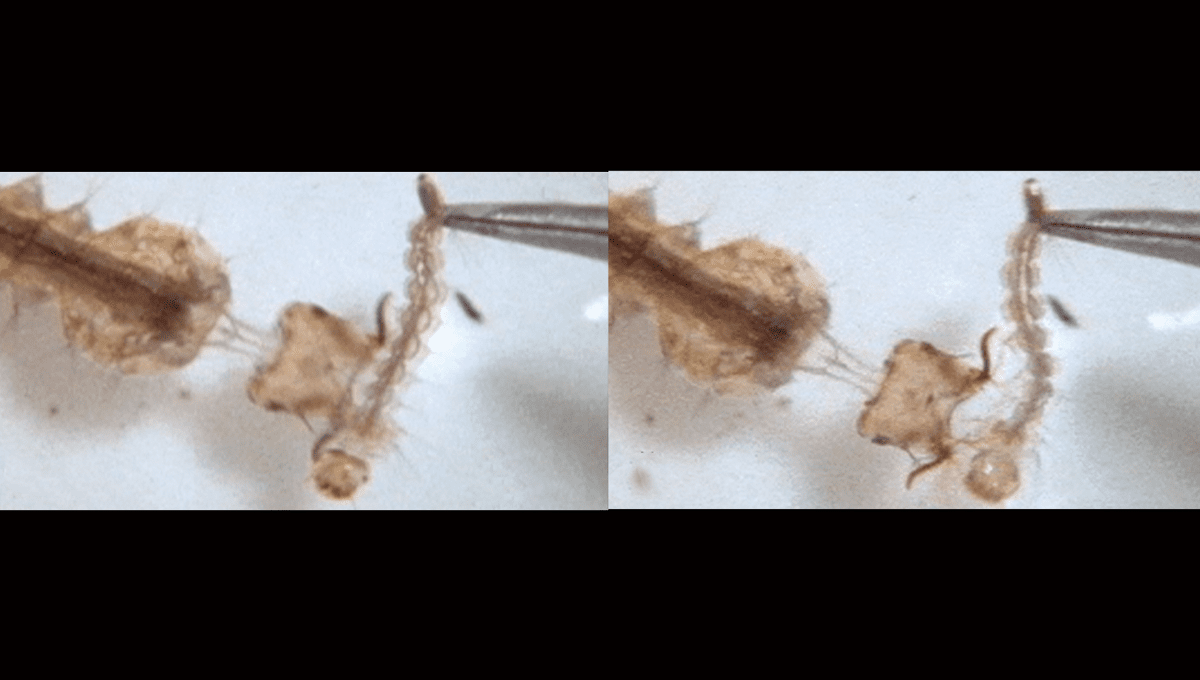
Using high-speed microcinematography, researchers have revealed the hunting techniques of three species of predatory mosquito larvae – and it’s quite literally head-popping.
The animal kingdom is full of weird and wonderful hunting techniques – ant-slayer spiders and parachuting octopuses anyone? However, nothing quite prepared us for the results of this new study, with larvae observed flinging their own heads on a thin string towards their prey.
“These are very sophisticated, highly evolved predators, that happen to be larval stage mosquitoes,” L.J. Zwiebel, a mosquito researcher at Vanderbilt University unrelated to the study, told the New York Times.
Predatory mosquitoes of the family Cilicidae are very common in the insect world. The assumption that mosquito larvae are cannibalistic, and therefore the predators of other mosquito larvae, has been backed by studies on different species in South Florida, but not on the three species present in this study. Most previous research lacked the equipment to delve deeper into the techniques of their prey-capture mechanisms – until now.
Mosquito species Toxorhynchites amboinensis and Psorophora ciliata have the same three parts to their predatory behavior. The first is the buildup of hemostatic pressure in their abdomens to propel their heads towards the prey. The second involves the opening of the lateral palatal brushes (LPBs), specialized mouthparts of the mosquito larvae. The third terrifying element is to open their sharp-toothed mandibles as wide as possible, ready to deliver the killer bite to their victims
In contrast, the species Sabethes cyaneus has a completely different prey-capture technique that involves arching its body and scooping the prey towards the waiting mouth. When striking, Sa. cyaneus utilizes both its siphon (a tube usually used for breathing) and a curving body position to hook the prey larvae and pull it towards its waiting mouth. It then uses its mandibles to repeatedly tear into the prey and sometimes consume it, though the prey is not always fully eaten.
The researchers also conducted an experiment to see if this species would exhibit cannibalistic behavior towards larvae of the same species, but found that all of the larvae of the same species remained alive.
For Tx. amboinensis and Ps. ciliata, the predatory larvae were placed into a slide with water and the live prey larvae were presented to them.
Both Ps. ciliata and Tx. amboinensis did not rely on a siphon hunting technique but instead thrust their heads forwards towards the prey after a contraction of at least one of the abdominal segments. This was coupled with the rapid opening of both the LPBs and the mandibles. Just how far their heads travel towards the prey can be seen in this video below.
Lead researcher Dr Robert Hancock, a biologist at Metropolitan State University of Denver, told the New York Times that larvae hunting “looks like one of those contests where they’re shoving hot dogs into their stomachs.”
Despite the fact that both Tx. amboinensis and Ps. ciliata are only distantly related, they have both evolved very similar methods of prey-capture. The formation of prey-capture baskets involving the LPBs of the Toxorhynchites has not been observed before. Furthermore, hemostatic head propulsion as a predatory technique has also not been described before.
While Sa. cyaneus may have a less impressive technique; it is arguably capable of capturing prey that is further away owing to the sweeping arch method that it uses. While Sa.cyaneus was capable of killing the other mosquito larvae, the eating of them was judged to be “inefficient and awkward” by the authors.
They therefore suggest that the Sa. cyaneu are simply murdering these larvae to reduce competition rather than killing them for food. Yikes.
The paper is published in Annals of the Entomological Society of America.
Source Link: Cannibalistic Head-Popping Mosquito Hunting Techniques Revealed By High Speed Cameras